Latin America
Related: About this forum'You're not alone': Guatemalan anthropologist offers support for unmarked graves searches
Fredy Peccerelli says Indigenous communities can and should develop own forensic anthropology capacity
Brett Forester · CBC News · Posted: Mar 05, 2023 3:00 AM CST | Last Updated: March 5
https://i.cbc.ca/1.6765959.1677790827!/fileImage/httpImage/image.JPG_gen/derivatives/16x9_780/fafg-forensic-archaeology-1-jpg.JPG
Workers with the Forensic Anthropology Foundation of Guatemala excavate remains in Guatemala. The foundation was created in 1997 following the end of the country's 36-year internal conflict. (FAFG)
Warning: This story contains distressing details.
The head of a Guatemalan forensic anthropology group is offering his support for Indigenous communities in Canada as they investigate unmarked burials linked to residential schools.
When he was nine, Fredy Peccerelli's family fled Guatemala's civil war to New York City after his father was threatened by government death squads, but he later resolved to return.
Today, after leading searches for the war's mostly Mayan victims for 26 years, he's known as one of Guatemala's foremost experts in the field, and he's willing to share his expertise with Indigenous communities here.
"You're not alone," he said.
"Your Mayan brothers and sisters have gone through this for the last many decades searching for their loved ones."
More:
https://www.cbc.ca/news/indigenous/fafg-peccerelli-guatemala-unmarked-graves-1.6765949
~ ~ ~
Representative history of massacres of original citizens in Central America:
Río Negro massacres
Five massacres occurred in the Rio Negro (“Black River”) communities between 1980 and 1982. The people of Rio Negro (named after the nearby river) had occupied the region since the classic Mayan age and owned 1,440 hectares of land. During the energy crisis of the 1970’s the Guatemalan government looked for local energy alternatives, creating the state-owned National Institute of Electrification (INDE). In 1975 INDE unveiled plans to dam the Rio Negro, also called the Chixoy River, to provide the country’s electricity, which would flood 31 miles of the river valley. Funds from the Inter-American Development Bank, Italian company Cogefar-Impressit, and the World Bank were used in the construction of local roads and the dam itself.
. . .
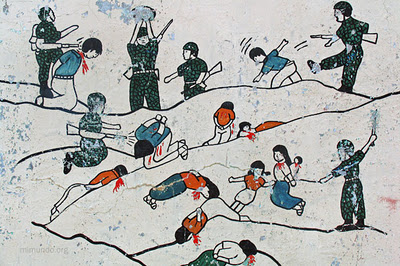
In 1981, the Guatemalan government began destroying villages as part of the scorched earth campaign, and relocating communities in ‘model villages’ that could be easily controlled and monitored by the army and also provide cheap labor to neighboring towns. The government also created Civil Defense Patrols, made up of armed locals, often forcefully recruited. One such patrol was created in the village of Xococ, near Rio Negro.
In February 1982, villagers in Rio Negro were instructed to bring their identification cards to Xococ. When the villagers reached the town they were murdered by the Xococ Patrol. One woman escaped and returned to Rio Negro to warn the other villagers. The men of the village decided to flee and hide in the hills leaving the women and children in the village, under the assumption they would not be harmed. The next month Civil Patrols from Xococ arrived in Rio Negro, under the pretense of guerrilla activity in the area, and massacred the women and children, killing 177.
Two months later, 84 more people were killed in ‘Los Encuentros’, Rio Negro, and fifteen women were abducted. Then, in September, 92 villagers were burned alive, including survivors of previous massacres. Of Rio Negro’s almost 800 Maya-Achí inhabitants, 444 were killed in the massacres between 1980 and 1982.
More:
https://www.ghrc-usa.org/our-work/2014-annual-report/rio-negro/
~ ~ ~


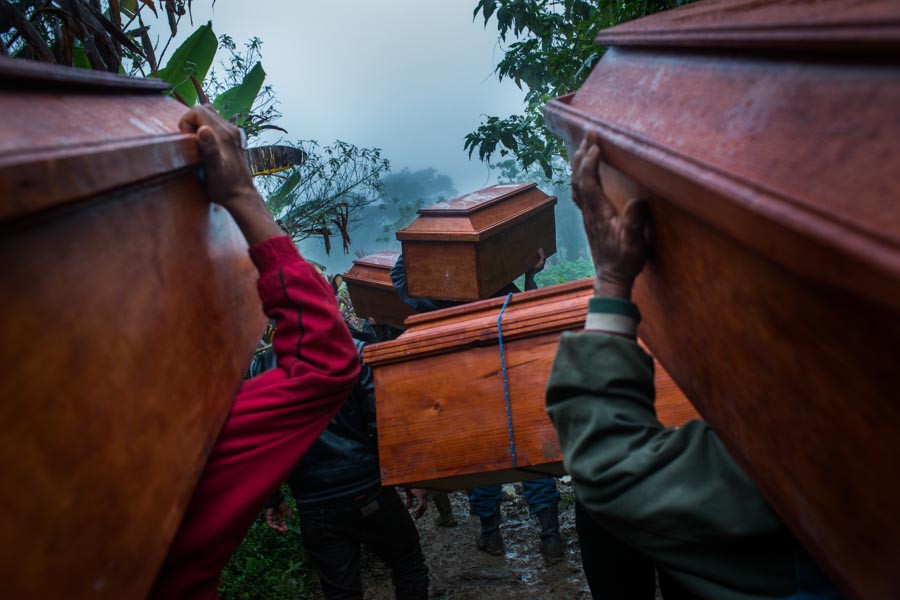
Guatemalans carrying the remains of their murdered loved ones to be properly reburied.
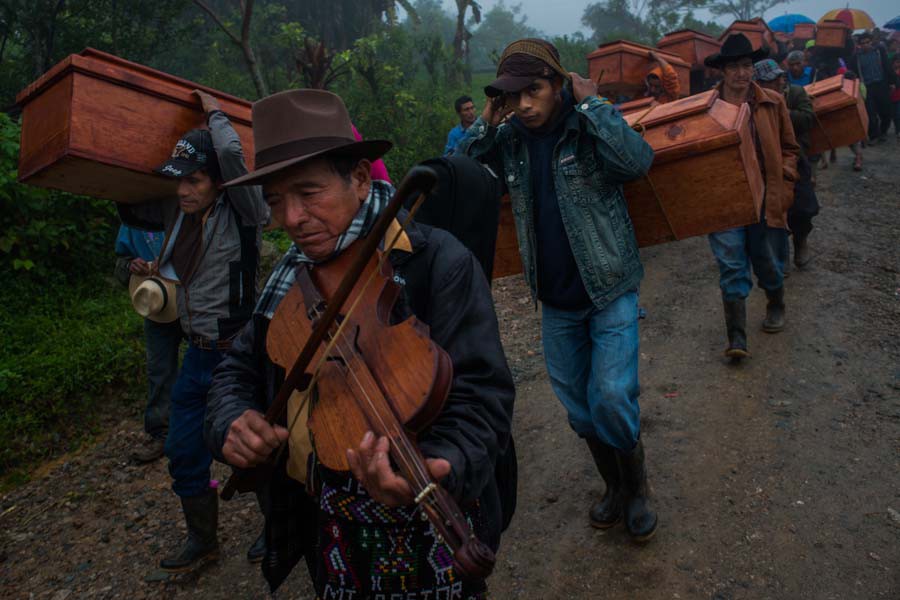
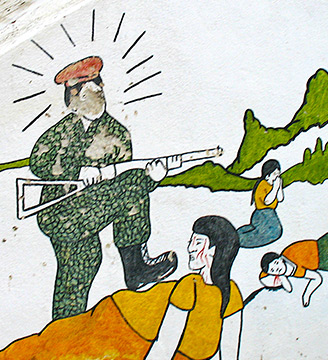
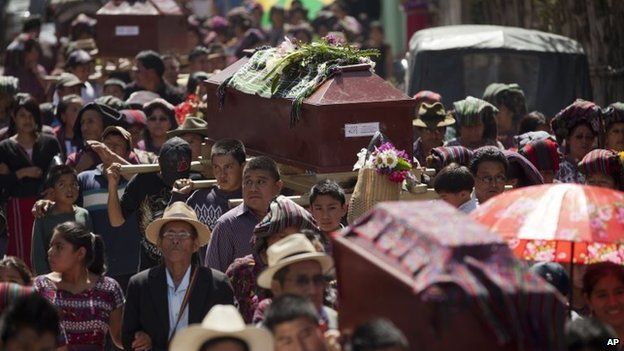
~ ~ ~
Wikipedia on
Río Negro massacres
Mar 4, 1980 – Sep 14, 1982
https://en.wikipedia.org/wiki/R%C3%ADo_Negro_massacres
riversedge
(70,236 posts)Putin and his missiles hitting towns and hospitals ![]()
![]()
Representative history of massacres of original citizens in Central America:
Río Negro massacres
Five massacres occurred in the Rio Negro (“Black River”) communities between 1980 and 1982. The people of Rio Negro (named after the nearby river) had occupied the region since the classic Mayan age and owned 1,440 hectares of land. ...................................................
In 1981, the Guatemalan government began destroying villages as part of the scorched earth campaign, and relocating communities in ‘model villages’ that could be easily controlled and monitored by the army and also provide cheap labor to neighboring towns. The government also created Civil Defense Patrols, made up of armed locals, often forcefully recruited. One such patrol was created in the village of Xococ, near Rio Negro.
In February 1982, villagers in Rio Negro were instructed to bring their identification cards to Xococ. When the villagers reached the town they were murdered by the Xococ Patrol. One woman escaped and returned to Rio Negro to warn the other villagers. The men of the village decided to flee and hide in the hills leaving the women and children in the village, under the assumption they would not be harmed. The next month Civil Patrols from Xococ arrived in Rio Negro, under the pretense of guerrilla activity in the area, and massacred the women and children, killing 177.
Two months later, 84 more people were killed in ‘Los Encuentros’, Rio Negro, and fifteen women were abducted. Then, in September, 92 villagers were burned alive, including survivors of previous massacres. Of Rio Negro’s almost 800 Maya-Achí inhabitants, 444 were killed in the massacres between 1980 and 1982.
More:
https://www.ghrc-usa.org/our-work/2014-annual-report/rio-negro/